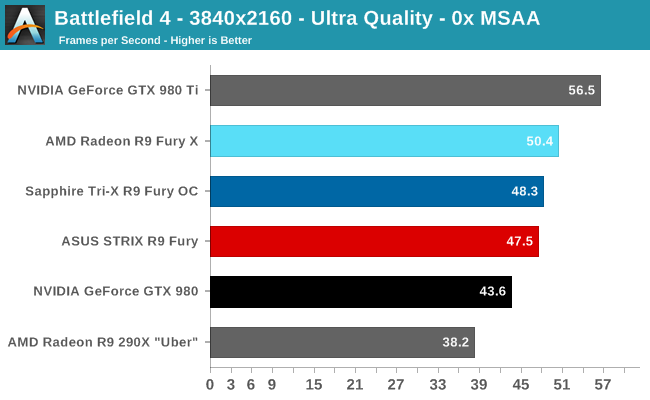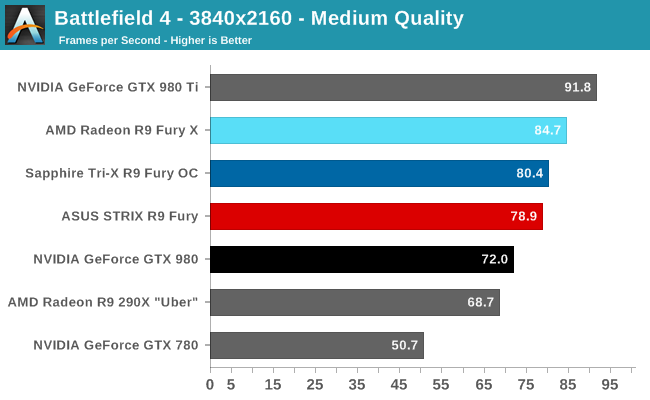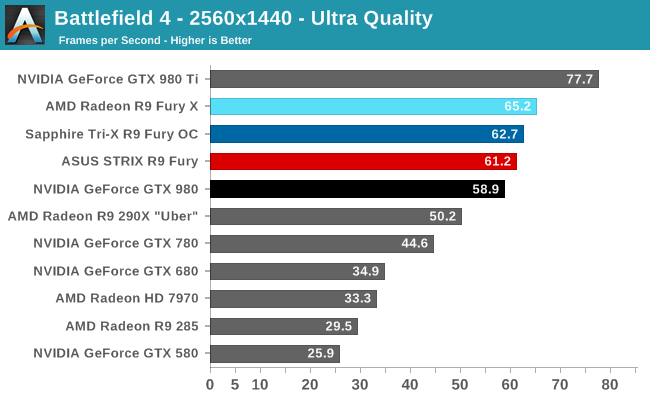The AMD Radeon R9 Fury Review, Feat. Sapphire & ASUS
by Ryan Smith on July 10, 2015 9:00 AM ESTBattlefield 4
Kicking off our benchmark suite is Battlefield 4, DICE’s 2013 multiplayer military shooter. After a rocky start, Battlefield 4 has since become a challenging game in its own right and a showcase title for low-level graphics APIs. As these benchmarks are from single player mode, based on our experiences our rule of thumb here is that multiplayer framerates will dip to half our single player framerates, which means a card needs to be able to average at least 60fps if it’s to be able to hold up in multiplayer.



When the R9 Fury X launched, one of the games it struggled with was Battlefield 4, where the GTX 980 Ti took a clear lead. However for the launch of the R9 Fury, things are much more in AMD’s favor. The two R9 Fury cards have a lead just shy of 10% over the GTX 980, roughly in-line with their price tag difference. As a result of that difference AMD needs to win in more or less every game by 10% to justify the R9 Fury’s higher price, and we’re starting things off exactly where AMD needs to be for price/performance parity.
Looking at the absolute numbers, we’re going to see AMD promote the R9 Fury as a 4K card, but even with Battlefield 4 I feel this is a good example of why it’s better suited for high quality 1440p gaming. The only way the R9 Fury can maintain an average framerate over 50fps (and thereby reasonable minimums) with a 4K resolution is to drop to a lower quality setting. Otherwise at just over 60fps, it’s in great shape for a 1440p card.
As for the R9 Fury X comparison, it’s interesting how close the R9 Fury gets. The cut-down card is never more than 7% behind the R9 Fury X. Make no mistake, the R9 Fury X is meaningfully faster, but scenarios such as these question whether it’s worth the extra $100.










288 Comments
View All Comments
Asomething - Friday, July 10, 2015 - link
Amd knows this and already made some decent leaps from gcn1.1 to gcn1.2 but nvidia are still way ahead on geometry.FlushedBubblyJock - Wednesday, July 15, 2015 - link
Mr know it all sure read well..... didn't you, mr wise meister...Thank god you are here with your gigantic brain
QUOTE: " This indicates that at least for the purposes of the 3DMark test, the R9 Fury series is ROP bottlenecked "
YEP SURE AIN'T THOSE ROPs !
64 just like the FURY X, meaning the Fury X is MORE ROP BOTTLENECKED !
Thanks for playing amd fanboy... it's been so beneficial to have your ultimate knowledge and experience to reign in rumors and place the facts on the table.
tviceman - Friday, July 10, 2015 - link
Hey Ryan -Since you've loaded Fury X OC numbers in the the bench database, is there any chance you can load Fury OC, 980 TI OC, and 980 OC numbers as well? Overclocking cards, but choosing not to compare OC'd results against OC'd results of other cards makes it tedious to flip back and fourth. Basically I want to see your 980 OC'd results vs. Fury OC'd results and going all the way back to the 980 launch isn't ideal since there have been driver improvements and game performance improving patches as well.
deppman - Friday, July 10, 2015 - link
I agree. The common practice of showing factory OC'd cards against reference designs is misleading. Showing an EVGA factory clocked 980 versus a Sapphire factory clocked Fury is a more realistic comparison. A factory OC'd 980 probably matches or beats the Fury at the same price. But I can't determine that here because there is no comparison :(Ryan Smith - Friday, July 10, 2015 - link
The Fury OC results actually aren't supposed to be live. That's an error.The problem with putting OC results in Bench is that we don't keep them updated. So they would quickly grow stale and not be valid results.
darkfalz - Saturday, July 11, 2015 - link
The main problem with putting OC results in bench is YMMV. I've yet to get a card that's overclocked as well as the reviewed version (granted, you tend to find faults weeks or months after, whereas in a review they only need to be "stable" for that few days or a week during the review). Unigine Valley at Ultra / 4K DSR is a really good test for me.deppman - Sunday, July 12, 2015 - link
"The main problem with putting OC results in bench is YMMV"This is true if you personally overclock the card. However, the Sapphire is "factory clocked" higher and is guaranteed and warrantied at that clock - and it also performs better as a result. The EVGA GTX 980 Superclocked ACX 2.0 with a factory clock of 1266/1367MHz (about 10% above reference) is also guaranteed and warrantied at those clocks.
Including a card like this in the benchmarks would provide a real-world comparison to the Sapphire. At the very least it should at least be *mentioned* in the OC section or conclusions. Something like "Of course, the real elephants in the room are the GTX 980's from board partners like EVGA which are clocked 10% or more above reference. Maxwell has proven to scale very well with clock speed, and these should provide comparable or better performance than the Sapphire for nearly $100 less at current prices."
xenol - Friday, July 10, 2015 - link
I felt like AMD should've released this at $500 and put NVIDIA in a bit of a bind in that market sector.DigitalFreak - Friday, July 10, 2015 - link
AMD isn't in a position where they can afford to lose money on these cards.extide - Friday, July 10, 2015 - link
I HIGHLY doubt they would lose money at $500, however they definitely do want to get every last penny they can.